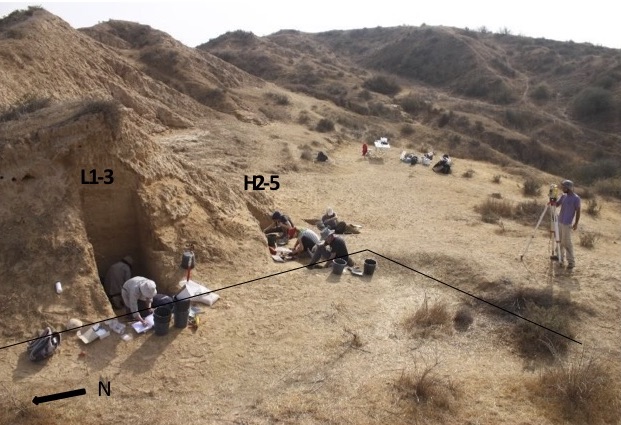From the Field
Mae Goder-Goldberger, from Ben-Gurion University of the Negev, was awarded a Leakey Foundation Research Grant during our spring 2017 cycle for her project entitled “The site of Far’ah II, western Negev, and the MP-UP transition.”

The main goal of this project was to study technological strategies and subsistence behaviors of the hominids who lived on the fringes of the Negev Desert, Israel, within their environmental context. The Farah II site previously excavated by Isaac Gilead (Ben Gurion University) is thought to have been inhabited at ~60-45 ka, a time span during which a substantial change is evident in the cultural material of the region. This change marks the Middle to Upper Paleolithic and has traditionally been associated with the dispersal of modern humans into Eurasia.
The site of Farah II is in the western Negev desert, Israel, situated on the banks of Wadi Habsor, western Negev, in a loess terrain cut by numerous gullies. This open-air site presents two archaeological surfaces embedded in well-stratified Loess sediments and awards an excellent chance to study a well preserved archaeological assemblage thought to date at the verge of the Upper Paleolithic. It is expected that deciphering the technological templates revealed at the site and understanding their environmental context will shed light on the causes for the changes in technology at the onset of the Upper Paleolithic at ~45 ka.
In November 2017, we spent 10 days in the field thanks to a Leakey Foundation grant. During the season we excavated the late living surface and collected all the samples needed for further research.

A total of 10 square meters were excavated in sub-squares of 0.25 x 0.25 cm. Once we arrived at the archaeological horizon, all the artifacts and bones were exposed, photographed, and plotted using the total station. As the bones were very fragile due to bad preservation, they were partially preserved with a dilute glueacetone solution in the field prior to their removal. Enough of each large bone was left unexposed to the glue so that chemical and isotopic analyses could be undertaken once we got them back to the lab.


Samples were collected for both 14C and OSL dating, with more than 30 charcoal fragments collected from the exposed living surface and 6 OSL samples taken from below, within and above the archaeological horizon.

During our field season, we collected 854 Middle Paleolithic flint artifacts with clear evidence of the Levallois technology. A technological analysis is being carried out, which will incorporate the finds from this excavation with over 5000 artifacts from Gilead’s excavations. The collected faunal assemblage includes around 200 unidentified bone fragments of varying size, as well as at least two equid teeth and a large ungulate maxilla. The species identification of the latter remains will be confirmed once they are cleaned and conserved, however, based on size and previously identified specimens from the site, the maxilla appears to belong to either an aurochs (Bos primigenius) or a hartebeest (Alcelphus bucelaphus). The equid/s represented are either onagers (E. hemionus onager) or African wild ass (Equus africanus). Cleaning of the faunal remains is in progress and will facilitate species identification as well as examination of bone taphonomy (presence of cut marks, burning, breakage etc.).

During the renewed excavation at Farah II, we successfully located the uppermost Middle Paleolithic archaeological horizon described by Gilead and Grigson (1984). A rich lithic and faunal assemblage was documented in situ and retrieved. Numerous charcoal fragments were located, documented and collected, and sediment samples were collected for further granulometric, pollen and phytolith analysis. In sum, this short field season has provided the basis with which to achieve the research goals set for this project.
We would like to thank the volunteers and archaeology students from the Ben-Gurion University who participated in the excavation. The excavation (Israel Antiquity Authority License No. G-90/2017 and with permission from the Israel Nature and Parks Authority) was led by Mae Goder-Goldberger (Archaeologist, Ben-Gurion University) in collaboration with Liora Kolska Horwitz (Archaeozoology, Hebrew University), Elisabetta Boaretto (14C dating and charcoal analysis, Weizmann Institute), Onn Crouvi (Sediments, Geological Survey of Israel) and Naomi Porat (OSL dating, Geological Survey of Israel).



